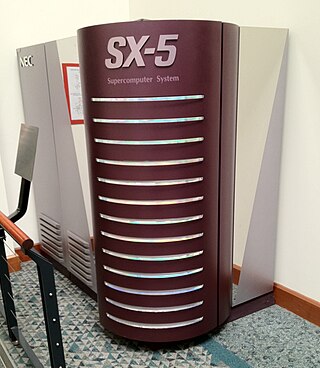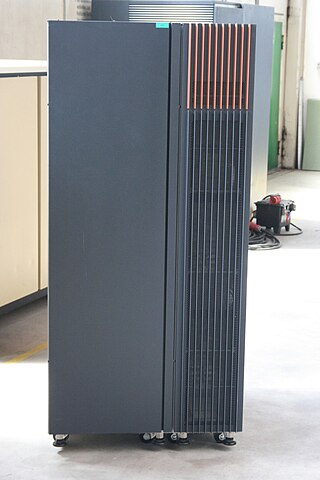
A supercomputer is a computer with a high level of performance as compared to a general-purpose computer. The performance of a supercomputer is commonly measured in floating-point operations per second (FLOPS) instead of million instructions per second (MIPS). Since 2017, there have existed supercomputers which can perform over 1017 FLOPS (a hundred quadrillion FLOPS, 100 petaFLOPS or 100 PFLOPS). For comparison, a desktop computer has performance in the range of hundreds of gigaFLOPS (1011) to tens of teraFLOPS (1013). Since November 2017, all of the world's fastest 500 supercomputers run on Linux-based operating systems. Additional research is being conducted in the United States, the European Union, Taiwan, Japan, and China to build faster, more powerful and technologically superior exascale supercomputers.

In computing, floating point operations per second is a measure of computer performance, useful in fields of scientific computations that require floating-point calculations. For such cases, it is a more accurate measure than measuring instructions per second.
The Earth Simulator (ES) is a series of supercomputers deployed at Japan Agency for Marine-Earth Science and Technology Yokohama Institute of Earth Sciences.

Blue Gene is an IBM project aimed at designing supercomputers that can reach operating speeds in the petaFLOPS (PFLOPS) range, with low power consumption.

ASCI White was a supercomputer at the Lawrence Livermore National Laboratory in California, which was briefly the fastest supercomputer in the world.

ASCI Red was the first computer built under the Accelerated Strategic Computing Initiative (ASCI), the supercomputing initiative of the United States government created to help the maintenance of the United States nuclear arsenal after the 1992 moratorium on nuclear testing.
ASCI Blue Pacific was a supercomputer installed at the Lawrence Livermore National Laboratory (LLNL) in Livermore, CA at the end of 1998. It was a collaboration between IBM and LLNL.

NEC SX describes a series of vector supercomputers designed, manufactured, and marketed by NEC. This computer series is notable for providing the first computer to exceed 1 gigaflop, as well as the fastest supercomputer in the world between 1992–1993, and 2002–2004. The current model, as of 2018, is the SX-Aurora TSUBASA.

The SX-8 is a supercomputer built by NEC Corporation. The SX-8 Series implements an eight-way SMP system in a compact node module and uses an enhanced version of the single chip vector processor that was introduced with the SX-6. The NEC SX-8 processors run at 2 GHz for vectors and 1 GHz for scalar operations. The SX-8 CPU operates at 16 GFLOPS and can address up to 128 GB of memory. Up to 8 CPUs may be used in a single node, and a complete system may have up to 512 nodes. The SX-8 series ranges from the single-CPU SX-8b system to the SX-8/4096M512, with 512 nodes, 4,096 CPUs, and a peak performance of 65 TFLOPS. There is up to 512 GB/s bandwidth per node. The SX-8 runs SUPER-UX, a Unix-like operating system developed by NEC.

The RISC System/6000 (RS/6000) is a family of RISC-based Unix servers, workstations and supercomputers made by IBM in the 1990s. The RS/6000 family replaced the IBM RT PC computer platform in February 1990 and was the first computer line to see the use of IBM's POWER and PowerPC based microprocessors. In October 2000, the RS/6000 brand was retired for POWER-based servers and replaced by the eServer pSeries. Workstations continued under the RS/6000 brand until 2002, when new POWER-based workstations were released under the IntelliStation POWER brand.

The TOP500 project ranks and details the 500 most powerful non-distributed computer systems in the world. The project was started in 1993 and publishes an updated list of the supercomputers twice a year. The first of these updates always coincides with the International Supercomputing Conference in June, and the second is presented at the ACM/IEEE Supercomputing Conference in November. The project aims to provide a reliable basis for tracking and detecting trends in high-performance computing and bases rankings on HPL benchmarks, a portable implementation of the high-performance LINPACK benchmark written in Fortran for distributed-memory computers.

JUGENE was a supercomputer built by IBM for Forschungszentrum Jülich in Germany. It was based on the Blue Gene/P and succeeded the JUBL based on an earlier design. It was at the introduction the second fastest computer in the world, and the month before its decommissioning in July 2012 it was still at the 25th position in the TOP500 list. The computer was owned by the "Jülich Supercomputing Centre" (JSC) and the Gauss Centre for Supercomputing.
The Green500 is a biannual ranking of supercomputers, from the TOP500 list of supercomputers, in terms of energy efficiency. The list measures performance per watt using the TOP500 measure of high performance LINPACK benchmarks at double-precision floating-point format.
The QCDOC is a supercomputer technology focusing on using relatively cheap low power processing elements to produce a massively parallel machine. The machine is custom-made to solve small but extremely demanding problems in the fields of quantum physics.
Marc Snir is an Israeli American computer scientist. He holds a Michael Faiman and Saburo Muroga Professorship in the Department of Computer Science at the University of Illinois at Urbana-Champaign. He currently pursues research in parallel computing. He was principal investigator (PI) for the software of the petascale Blue Waters system and co-director of the Intel and Microsoft funded Universal Parallel Computing Research Center (UPCRC).

IBM Sequoia was a petascale Blue Gene/Q supercomputer constructed by IBM for the National Nuclear Security Administration as part of the Advanced Simulation and Computing Program (ASC). It was delivered to the Lawrence Livermore National Laboratory (LLNL) in 2011 and was fully deployed in June 2012. Sequoia was dismantled in 2020, its last position on the top500.org list was #22 in the November 2019 list.
The Hitachi SR2201 was a distributed memory parallel system that was introduced in March 1996 by Hitachi. Its processor, the 150 MHz HARP-1E based on the PA-RISC 1.1 architecture, solved the cache miss penalty by pseudo vector processing (PVP). In PVP, data was loaded by prefetching to a special register bank, bypassing the cache. Each processor had a peak performance of 300 MFLOPS, giving the SR2201 a peak performance of 600 GFLOPS. Up to 2048 RISC processors could be connected via a high-speed three-dimensional crossbar network, which was able to transfer data at 300 MB/s over each link.

The K computer – named for the Japanese word/numeral "kei" (京), meaning 10 quadrillion (1016) – was a supercomputer manufactured by Fujitsu, installed at the Riken Advanced Institute for Computational Science campus in Kobe, Hyōgo Prefecture, Japan. The K computer was based on a distributed memory architecture with over 80,000 compute nodes. It was used for a variety of applications, including climate research, disaster prevention and medical research. The K computer's operating system was based on the Linux kernel, with additional drivers designed to make use of the computer's hardware.

Japan operates a number of centers for supercomputing which hold world records in speed, with the K computer becoming the world's fastest in June 2011. and Fugaku took the lead in June 2020, and furthered it, as of November 2020, to 3 times faster than number two computer.
The PRIMEHPC FX10 is a supercomputer designed and manufactured by Fujitsu. Announced on 7 November 2011 at the Supercomputing Conference, the PRIMEHPC FX10 is an improved and commercialized version of the K computer, which was the first supercomputer to obtain more than 10 PFLOPS on the LINPACK benchmark. In its largest configuration, the PRIMEHPC FX10 has a peak performance 23.2 PFLOPS, power consumption of 22.4 MW, and a list price of US$655.4 million. It was succeeded by the PRIMEHPC FX100 with SPARC64 XIfx processors in 2015.












